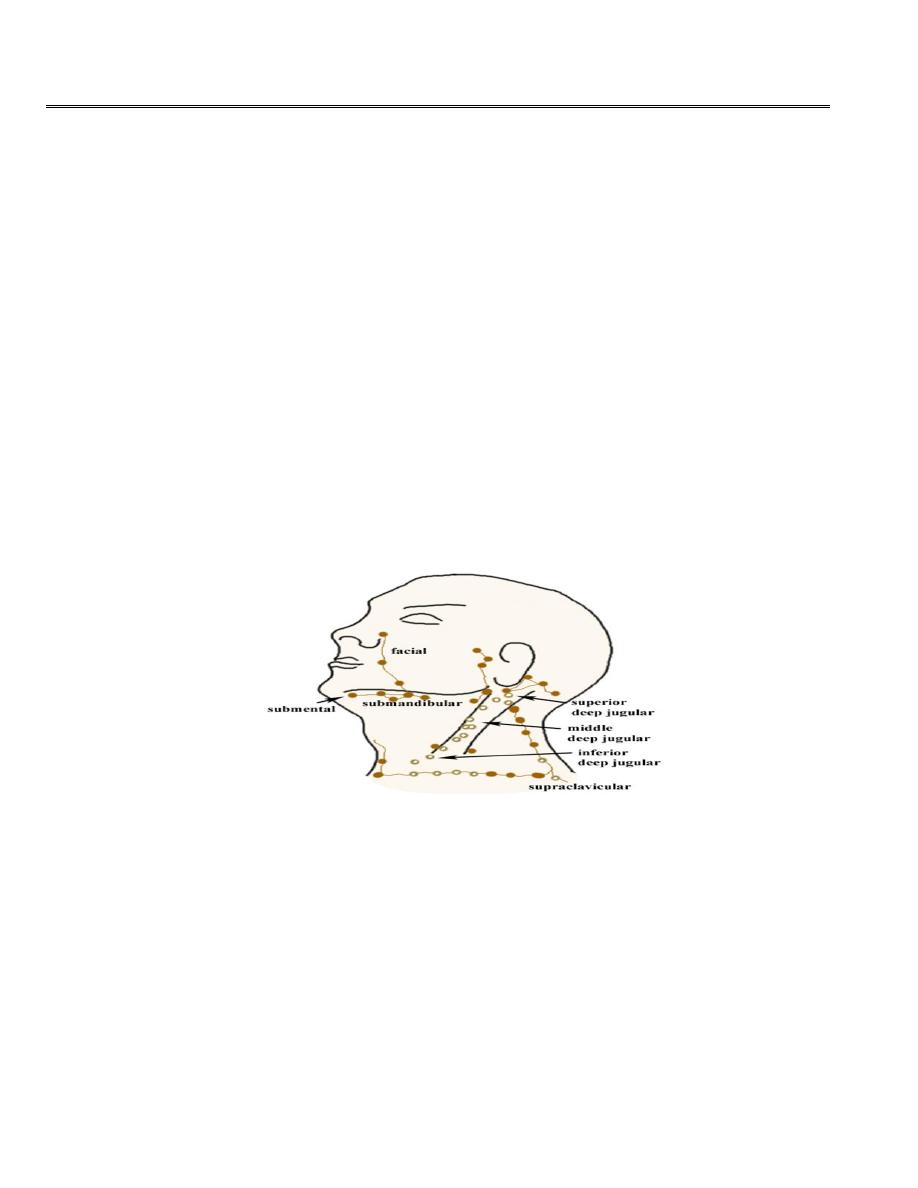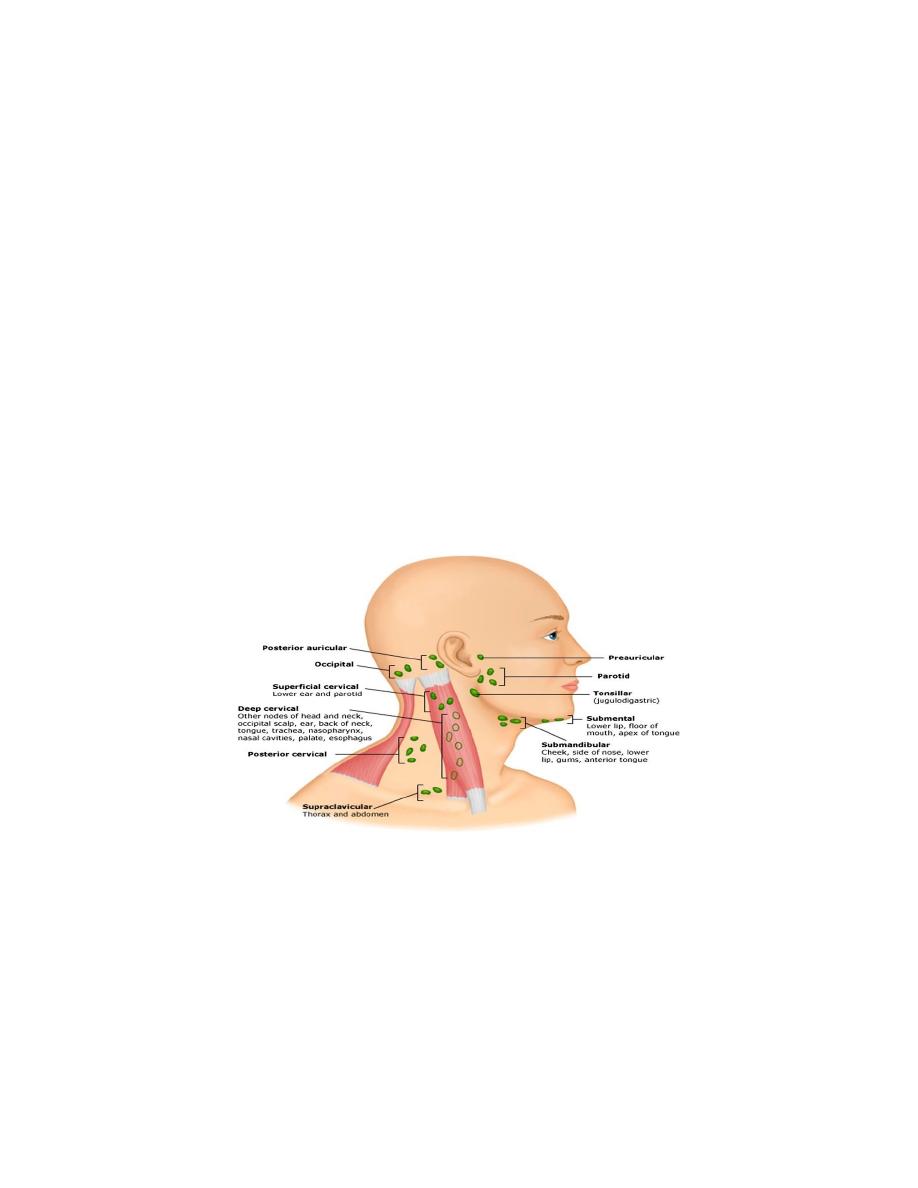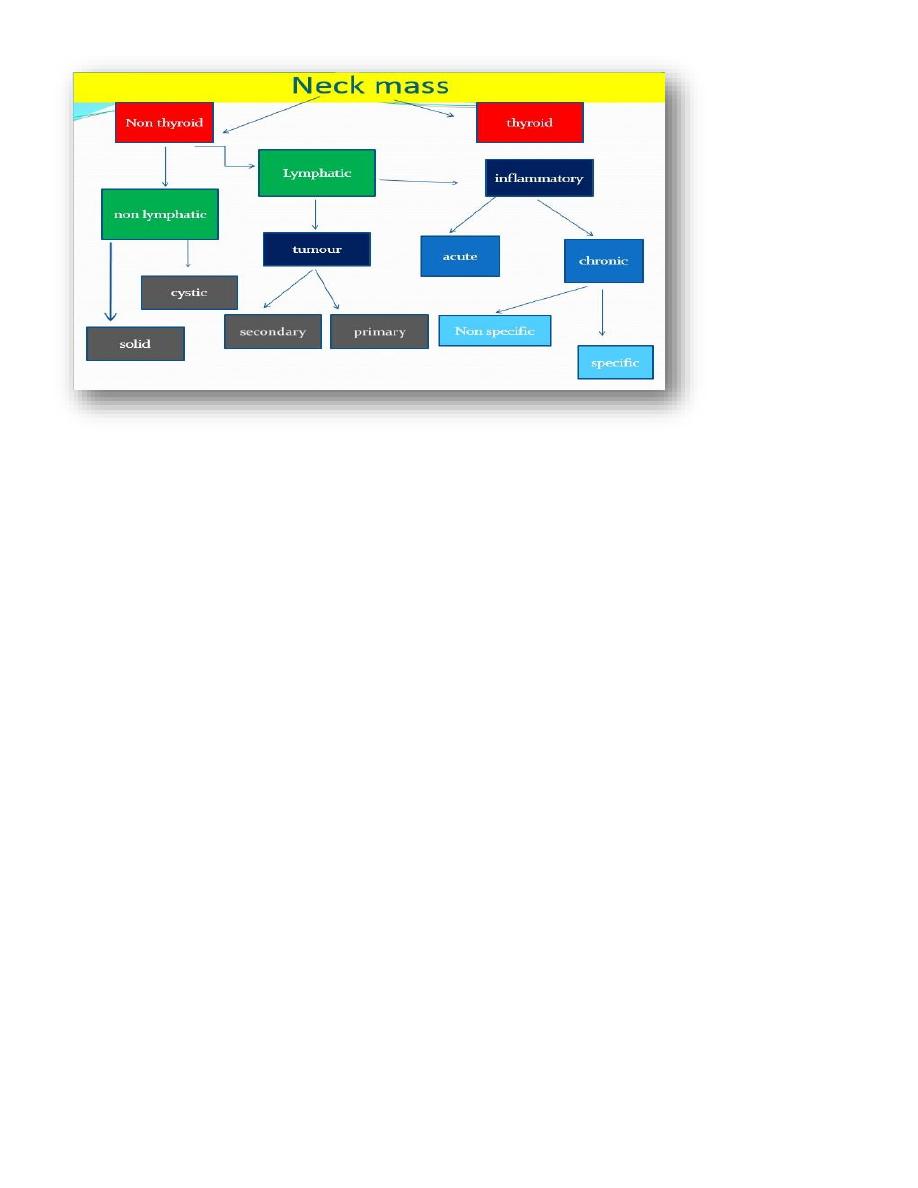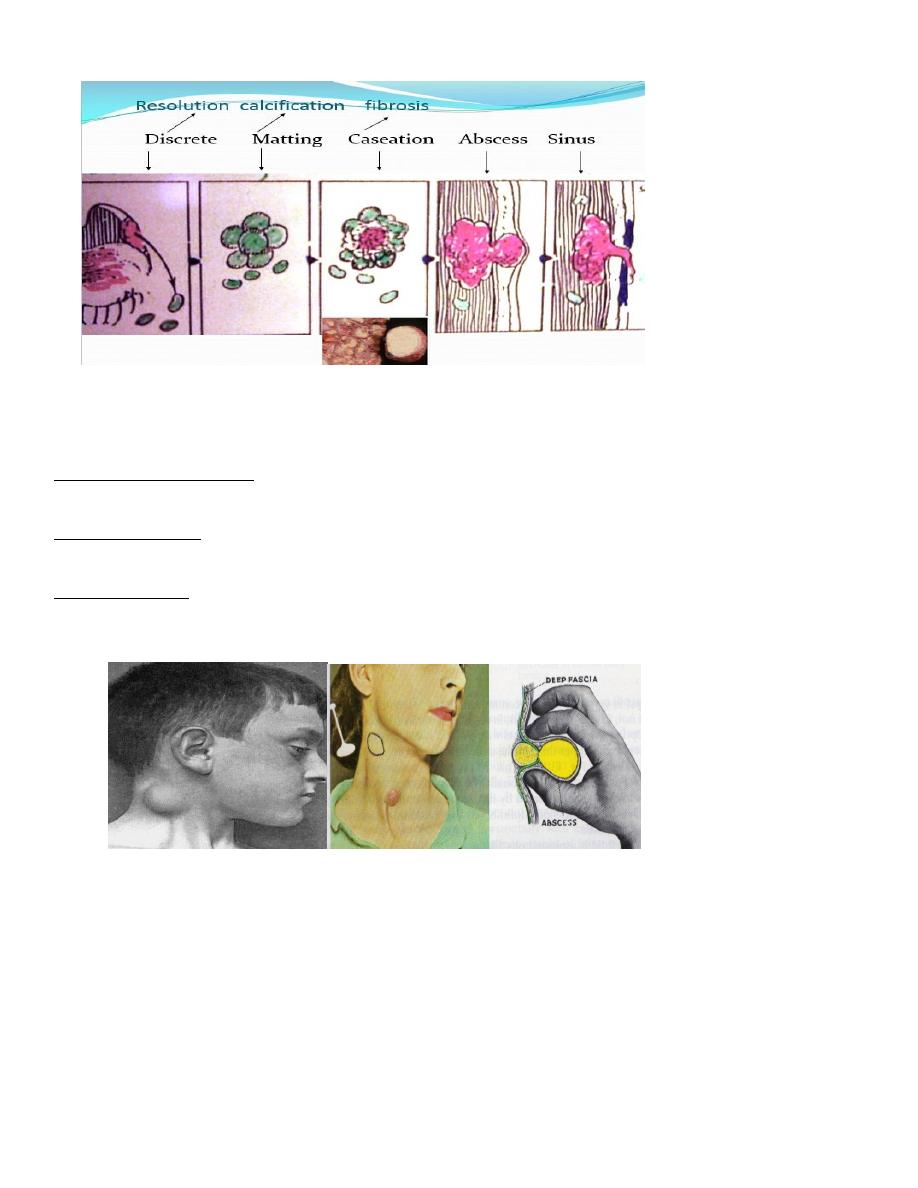
1
Forth stage
Surgery
Lec-6
د.نشوان
16/4/2016
LYMPHATIC DESEASE OF THE NECK
The body has approximately 600-800 lymph nodes.
Half of the lymph nodes in the neck, they are divided into groups according to anatomical
position and to levels.
Anatomically the neck divided into 4 triangles by medline, trapezeus, sternomastoid and
digastric muscles
1- the submental.
2- the submandibular.
3- anterior triangle.
4- posterior triangle.
Level I— the submental and submandibular nodes
Level Ia—the submental nodes.
drain the skin of the chin, the mid-lower lip, the tip of the tongue, and the anterior floor of the
mouth.
Level Ib—the submandibular nodes. Drain the lower nasal cavity, the hard and soft palate, the
maxillary and mandibular alveolar ridges, the cheek,
the upper and lower lips, and most of the anterior tongue.
Level II—upper jugular chain nodes drain the face, parotid gland, and the submandibular,
submental and retropharyngeal nodes, nasal cavity, pharynx, larynx, external auditory ca-nal,
middle ear, and from sublingual and submandibular glands.

2
Level III—middle jugular chain nodes drain the base of the tongue, tonsils, larynx,
hypopharynx and thyroid gland.
Level IV—lower jugular chain nodes drain from the hypopharynx, , esophagus, larynx, trachea
and thyroid gland.
Level V-posterior triangle nodes drain
the occipital and retro-auricular node, parietal and occipital scalp, nasopharynx, the
oropharynx and the thyroid gland.
Level VI—anterior compartment nodes. composed of the pre-laryngeal, pre-tracheal (delphen
LN)and para-tracheal (recurrent laryngeal nerve) nodes drain the anterior floor of mouth, the
tip of the tongue, the lower lip,, the glottic and subglottic larynx, the hypopharynx, thyroid
glandnd the cervical esophagus.
Level VII: contains the mediastinal lymph node drains esophagus.

3
ACUTE CERVICAL LAYMPHADENITIS
Infection is carried to LN from inflamed focus in head or neck, face, pharynx. larynx, tonsil, ear
, nose.
Mo=staph aureus, strept. Pyogens & anaerobe if dental cares.
Condition is more in children.
CLINICALLY:
Beside picture of the cause , there are LN are enlarged, unilateral, hot, red,tender, soft or
firm& if pus formed, fluctuation +ve. There may be tender red streaks between primary focus
& affected LN (Lymphangitis).
COMPLICATIONS:
Spread to more proximal LN.
Spread to nearby tissue .
Suppuration (Abscess).
MO remains dormant in LN & flare up later.
TRAETMENT:
Treat causative agent.

4
Rest & AB
local heat & review in 48 hours.
Incision & drainage if no response or fluctuation formed.
CHRONIC NON SPECIFIC LYMPHADENITS
ETIOLOGY
1. It is due to chronic infection of nearby focus like septic teeth, sinusitis, tonsillitis or
adenoiditis.
2. Chronic non specific lymphadenitis of post. triangle in children may be due to head
pediculosis or rubella.
3. Chronic non specific lymphadenitis following incomplete resolution of acute lymphadenitis.
CLINICALLY The LN are slightly enlarged, mobile, mildly tender & firm or elastic in consistency.
TREATMENT
Treatment of original focus .
Nodes need no treatment.
Chronic non specific lymphadenitis that persists for more than 3-4 months ;TB or
lymphomas must be excluded.
TUBERCULOUS LYMPHADENITIS (Scrofula or kings Evil)
It is common in children or young adults.
Commonest LN are JUGULODIGASTRIC. (level 2)
The MO reaches them from adenoids & tonsils from infected milk.
Both human and bovine type of TB MO can be responsible..
Pathology: The consequence of events are as follows:
1. TB lymphadenitis.
2. TB periadenitis involvement of the capsule presented as matted LN.
3. Multiple tubercles will form, coalesce, break down to form cold abscess.
4. Burst through the deep fascia into subcutaneous space producing collar stud abscess.
5. Rupture through skin producing TB sinus or ulcer.
At any stage ? resolution or calcification or fibrosis may happened.

5
CLINICALLY
General features : fever, night sweat, anorexia & weight loss The disease is unilateral in 80%
and limited to single group in 80%, may associated with pulmonary or renal TB in 20%.
Stage of lymph adenitis LN enlarged non tender not warm ,firm or elastic & matted to each
other.
The cold abscess, it is slightly warm not tender, connected to underlying caseating LN.
Fluctuation occur when the abscess burst to the superficial fascia to form collar stud abscess.
Sinus formation with thin blue margin, undermined edges & thin serous discharge. Healing of
sinuses leaves scar.
INVESTIGATIONS
1.CXR, CBP & E.S.R, lymhocytosis.
2.Tuberculine -ve.
3.LN biopsy ( T.B Granuloma).
4.Aspiration of cold abscess & guinea pig inoculation
5.Smears of sinus for AFB.

6
TREATMENT
IN stage of lymphadenitis :
Improve general condition
Anti TB( 9 months)
Surgical excision of single or group of LN if no response or complications.
IN cold abscess and sinus:
Anti TB.
Drainage.
Excision of underlying LN.
Tumour of lymphatic system in the neck
80% of tumour in the neck LN are secondary mostly from:
A- primary in head and neck (85%)
1-oral cavity.
2- nasopharynx.
3- oropharynx .
4-hypopharynx.
5- thyroid.
B- primary below the clavicle (15%)
1- bronchus.
2- esophagus, stomach, colon, pancreas.
3- testes, prostate.
The presence of cervical metastasis decreases the 5-year survival rate in patients by
approximately 50%.
Primary neck LN malignancy represent 20% of malignant tumour mostly in form of
Lymphomas ,Usually involve children & young adults ,
More common in male.
Clinically: Painless progressive enlargement of discrete rubbery LN, may associated with
hepato/Splenomegaly with or without constitutional symptom.

7
Character of LN involved by secondary malignant deposit are rapidly enlarged,hard, irregular
shape, fixed, painless and subsequent ulceration to skin.
The primary should always searched and managed accordingly.
Biopsy or fine needle aspiration are needed for confirmation of diagnosis.
Image study needed for diagnosis of the primary.
Treatment
The gold standard treatment for control of cervical metastasis is radical neck dissection (RND)
with en-block removal of the primary tumour if feasible.
The classic RND removes levels I to VI of the cervical lymphatics in addition to the
sternomastoid muscle, internal jugular vein, the spinal accessory nerve (CN XI) and
submandibular salivary gland.
Many incisions has been used.
The aim is to fulfill
1-Adequate exposure.
2-Capible for extension.
3- Cosmetically acceptable
4- Not damage vital structure under the skin
5- Avoid middle portion of the neck.
Any modification of the RND that preserves non-lymphatic structures (i.e., CN XI, SCM muscle,
or internal jugular vein) is defined as a modified radical neck dissection (MRND).
A neck dissection that preserves lymphatic compartments normally removed as part of a
classic RND is termed a selective neck dissection lateral2/3/4 posterolateral 2/3/4/5 or
supraomohyoid level1 (SND).
Radiotherapy
1-Can be used initially like in nasopharyngeal ca.
2- Recurrent nodal disease.
3- Residual tumour.

8
Complication of RND
A- Early:
1- Bleeding.
2-Pneumothorax.
3- Increase intracranial pressure due to ligation of IJV.
4-Chylus fistula due to injury to thoracic duct.
5- Carotid artery rapture.
B-Late:
1- Scar formation and disfiguring
2-Frozen shoulder
3- Recurrence of tumour.
